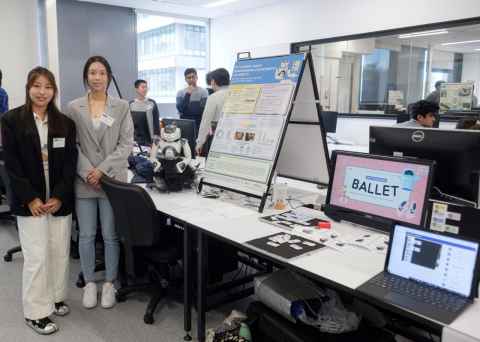Stephy Yu and Kirsty Gong
Two final year Engineering students prove that programming is not limited to age or gender.

Imagine you are in a classroom. The teachers are smiling, the children are laughing, and the tutu-wearing robots are dancing ballet.
This is not an ordinary class. This is a coding class for 5-10 year old girls. Breaking down stigma and barriers, two fourth-year engineering students decided to make a difference while completing their Part IV Project, a final year project.
Stephy Yu and Kirsty Gong are two students who believe that “programming is not limited to any specific age or gender,” and undertook their Part IV project Tangible-based Programming Environment for Robots as an opportunity to introduce young girls to programming.
The Faculty of Engineering requires every fourth-year student to complete a Part IV Project in their final year of their Bachelor of Engineering Honours degree. Part IV Projects are designed as learning experiences for students to approach and undertake problems the same way engineers do in their professional careers. They work in pairs showcasing what they have learned to the faculty, to their lecturers and to industry professionals.
Although their project ended up showcasing tangible programming, this was not their first choice for a project topic. In fact, they had two other choices that were claimed by other students before they could pursue them.
“We are so happy it was left over,” said Kirsty, “we were able to do something great with it, and it ended up being the best project.”
Tangible-based programming is a simple form of coding. If you think of coding like a language; where languages use words to communicate, tangible-based programming uses physical objects like buttons or switches. This makes it easier to learn if you have no previous knowledge.
Stephy and Kirsty decided to create and hold a workshop for girls aged 5-10 years. Tech has been a largely male-dominated industry. According to a study done by NZ Tech in 2021, women only make up 27% of the technology industry. This could be due to young girls receiving less access to coding resources before they get to university.
“Most primary and intermediate schools don’t have the facilities to introduce robots to kids” remarked Stephy, “we want to change that.”
After deciding in which direction they would like to take the project, this team looked at the best way they could bring coding to the younger generation. They found a previous year's Part IV Project, Synchronised Dancing Robots, by Jack Morrow-Zhang and Trinh Vo, and were inspired.
They decided to create their own version of dancing robots and set out to choose a style of dance. Initially Stephy and Kirsty chose hip-hop, but there were too many leg movements when programming and their robot kept falling over. Ballet became the next best option, not only because they could program more moves for the robot, but also because it meant they could add a tutu.
The Teams workshop consisted of eight girls between Year 1 and Year 6.
“The hardest part of the project was finding a way to keep the students engaged for the whole time,” said Stephy. So they supervised a series of guided and unguided tasks.
“After we taught them the basic steps, we let them go off and play with the program, creating their own dance,” said Kirsty.

The objects that Stephy and Kirsty used in their workshop were building blocks. These building blocks represented programming elements and commands, the tangible programming, and to make their robot dance, students had to arrange these blocks into a certain pattern to create their own unique ballet sequence. Arabesque, plié, fly!
By the end of the day, all the girls had programmed a robot to do a personalized dance. They couldn’t get enough! The girls were mesmerised, playing their dance over and over.. Until they discovered they could remove the tutu. That is when the kids took turns putting on the tutu and mimicked the robots, dancing and twirling like ballerinas.

The workshop was a huge hit, with parents approaching Stephy and Kirsty’s supervisor Craig Sutherland, raving about what an amazing experience this was, how much fun their daughters had, and how envious their sons were.
Stephy and Kirsty’s workshop was a roaring success and not just because their students loved making a robot dance. Stephy and Kirsty have shown these girls that anyone can code.
After the success in the classroom, Stephy and Kirsty took their workshop to the University of Auckland’s Display Day. Their dancing, tutu-wearing robot drew crowds with people circling back to play with it again.
Stephy enjoyed watching everyone interacting with it, “it was rewarding to watch people come up, eager to learn to code.” They continued their workshop at the MOTAT STEM fair, where even more children were able to learn how to program a robot, perhaps laying the building blocks for future engineers.
Tangible-based programming will continued to be offered as a Part IV project. If you are interested in this program contact Craig Sutherland or head over to https://part4project.foe.auckland.ac.nz/.

For more information on coding programs for girls check out:
https://girlcode.co.nz/
https://codeclub.nz/she-can-code
https://girlswhocode.com/programs/summer-immersion-program